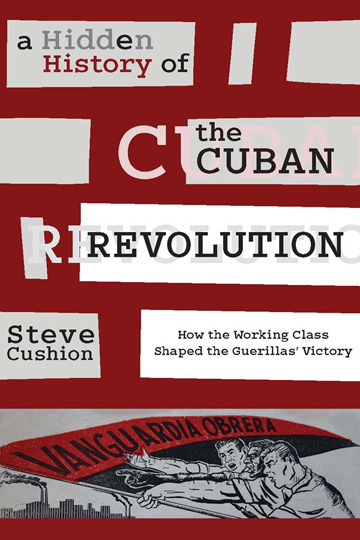
Steve Cushion’s new book shows that there’s more to the story of how Cuba’s revolution began than the romantic tale of a few warriors in the mountains vanquishing thousands of U.S.-equipped soldiers. In his Hidden History of the Cuban Revolution, this English labor historian demonstrates that “participation of militant organized labor” was crucial to what happened on January 1, 1959.
Cushion’s book is clearly-written and well-organized, but not easy reading. He necessarily records demonstrations and strikes, episodes of cruelty from Batista forces, economic trends, and variations in the ideology, purposes, and affiliations of participating groups and individuals. The detail and complexity are daunting.
The author centers his story on an almost six-year period that began with the rebel attack on Santiago’s Moncada barracks July 26, 1953 led by Fidel Castro. It tells about regular strikes and general strikes, the decline of Cuba’s sugar-based economy, employer abuses, and savage repression provoked by armed insurgency.
The narrative focuses on the two main opposition groups: the July 26 Revolutionary Movement (MR-26-7), allied to the guerrillas, and the Communist Party, known as the Popular Socialist Party (PSP). They jostled, but eventually moved toward collaboration, to what Cushion calls “convergence.”
Members of the middle class, intellectuals, and workers were part of the MR-26-7 and PSP alike. Each was aiming for a “democratic front” that would achieve immediate goals; neither was calling for socialism. The MR-26-7 wanted national liberation and democracy. First and foremost, the PSP sought economic gains for workers. The MR-26-7 wanted to overthrow the government and was relying on armed struggle and the general strike. The PSP initially was almost entirely interested in “mass struggle” – demonstrations and strikes – directed at economic betterment for workers. The PSP rejected armed struggle as a form of terrorism.
According to the author, MR-26-7 developed “workers’ sections” for putting “trade unionism on a war footing.” Workers associated with the MR-26-7 delivered supplies and arms to the guerrillas, engaged in sabotage, created revolutionary cells in workplaces, and organized a few local strikes. Experienced labor leaders led workers’ sections in Santiago and Guantánamo that were particularly strong.
The PSP during the 1950s focused on promoting strikes and demonstrations with the effect, says Cushion, of workers being radicalized. From the 1930s until the late 1940s, when Cold War pressures forced their removal, Cuban Communists had monopolized leadership positions within organized labor. After the Batista regime in 1953 declared the PSP to be illegal, the organization utilized old ties to the labor movement to form locally-based Committees for the Defense of Workers’ Demands (CDDO). Their purpose was facilitation of strike actions. The Communists’ ties to earlier Batista governments accounted in part for much anti-communist bias within the MR-26-7.
As the civil war intensified, MR-26-7 and the PSP each learned from experience and modified their positions. The PSP realized the necessity of armed resistance; otherwise savage state-sponsored repression of strikes would be continuing. The MR-26-7 recognized its overall failure in appealing to labor.
In August 1957, labor groups (with PSP assistance) spearheaded a successful general strike. Yet a general strike in April 1958 failed due to organizing lapses and exclusion of the PSP from the planning process.
In mid-1958, MR-26-7’s national leadership decided to prioritize the guerrilla struggle but also to “work with the Communist Party in the labor movement.” Soon MR-26-7 workers’ sections and the CDDOs of the PSP were holding joint meetings at the local level. Representatives of both organizations participated in two larger meetings. There, preparations for a revolutionary general strike were discussed.
Cushion indicates that as of January 1, 1959, “The rebel Army had driven the dictator from office, but had not yet succeeded in seizing power or changing the political and economic system.” But a military coup was being plotted and U.S. embassy officials were involved. A coup “could have split some of the middle class support away from the MR-26-7” and prolonged the civil war.
At that point, “Fidel Castro spoke over the radio from Santiago to condemn the coup attempts and to call for a revolutionary general strike … [F]rom the moment the call went out, the strike was complete.”
Cushion’s history is thus about political convergence. He presents workers as struggling to achieve social and economic gains, sort out allies, and balance compromise with sticking to principle. In the end, it seems, the Cuban working people, those who were organized, did achieve unity. Having done so, they set the stage for Cuba’s revolution to begin.
Steve Cushion is saying implicitly that in view of such happenings, the Cuban state is indeed a workers’ state, and that no one should be surprised that Cuba’s single political party is a communist party. Actually, it’s a new one that in 1965 absorbed the old PSP.
Steve Cushion, “Hidden History of the Cuban Revolution,” ISBN:9781583675816, (Monthly Review Press, NY, 2016), 272 pp, paperback – $27

MOST POPULAR TODAY

High Court essentially bans demonstrations, freedom of assembly in Deep South

U.S. imperialism’s ‘ironclad’ support for Israel increases fascist danger at home

Resource wars rage in eastern Congo, but U.S. capitalism only sees investment opportunity


UN warns that Israel is still blocking humanitarian aid to Gaza






Comments